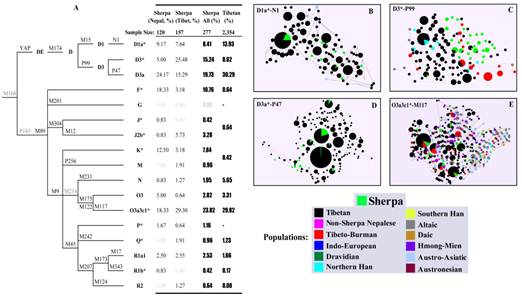Following the groundbreaking ascent of Mount Everest In 1953 by Tenzing Norgay and Sir Edmund Hillary, the Sherpa people gained such cachet that their name became vernacular shorthand and pop culture reference for much of the twentieth century. In Nepal today, many Sherpas rely on serve as Mountaineering enthusiasts’ Poter and guider for a living.
Sherpas live in the Khumbu region of Nepal and smaller settlements along the Sino-Nepalese border in the Tibet Autonomous Region of China in Dingjie County and Zhangmu Town, along with the border regions of China with India and Bhutan. Previous studies have resulted in different standpoints about the geographic origin and prehistoric migratory history of the Sherpas. A recent genetic study went so far as to posit that Sherpas and Han Chinese were the two ancestral populations of modern Tibetans, and consequently the genetic adaptation to high altitude hypoxia seen among Tibetans was likely inherited from the ancestral Sherpas. Conversely, a recent study of mtDNA diversity on a small Sherpa sample from Zhangmu Town in Tibet reported two Sherpa-specific haplotypes with relatively young ages (<1,500 years), suggesting a Tibet into Nepal migration granting the Sherpas’ well-known adaptation at high altitudes. The disparity in these two views reflects a fundamental divide in the evolution of adaptive features among Sherpas, holding to either a short (<1500 years) or long (30,000 years) duration of colonization at high altitude. Complicating this controversy is the limited genetic studies of populations from the southern Himalayas, leaving the answer of when and where the Sherpa people originated and settled at the high altitude regions of Nepal unclear.
In the present study, we analyzed Y-chromosome and mtDNA diversity of 582 unrelated Sherpa samples collected from different places in both Nepal and Tibet. We have genotyped the Y-SNPs and Y-STRs for 277 male Sherpa samples. We also sequenced the complete mtDNA genomes of 89 Sherpa individuals and genotyped other 493 samples based on the control region (HVS-I and HVS-II) and partial coding regions of mtDNA. Data from both the paternal and maternal markers indicates that the Sherpa people are a recently derived sub-lineage of Tibetans, supporting a short colonization and settlement in the southern Himalayas. This study is published on “Scientific Reports” ( www.nature.com/articles/srep16249).
This study was supported by grants from the Strategic Priority Research Program of the Chinese Academy of Sciences, the National 973 Program of China, and the National Natural Science Foundation of China.

Figure Legend: Comparison of Y chromosome diversity among Sherpas, Tibetans and other Asian populations. (A) Phylogenetic tree of the Y chromosome haplogroups and their frequency distributions in Sherpas and Tibetans. (B-E) The Y-STR networks of the four major haplogroups showing the distributions of STR haplotypes in Sherpas and other Asian populations. Populations were labeled with different colors based on their belonged language families.
Contacts:
Dr. Xiaoming ZHANG, Associate Professor
Comparative Genomic Group, State Key Laboratory of Genetic Resources and Evolution, Kunming Institute of Zoology, Chinese Academy of Sciences
Address: No.32, Eastern Jiaochang Rd, Kunming 650223, Yunnan Province, China.
E-mail: zhangxiaoming@mail.kiz.ac.cn
Phone: 086-0871-65120202
